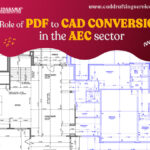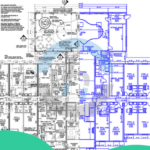Quick Summary: Millwork drawings include precise plans and diagrams that supply crucial information for architects. They serve as a blueprint to design and build specific millwork pieces including doors, cabinets, and moldings. They help ensure the accuracy and precise implementation of the design, which allows architects to communicate their vision to builders and craftsmen.
What are Millwork Shop Drawings?
Millwork shop drawings are handmade or digitally generated blueprints prepared by professional drafters. These are specified as detailed plans that describe the design, dimensions, and materials that shall be used in the execution of a custom millwork project.
Their importance is in the accuracy of materials production and installation operations as well as serving as a guidelines compilation for architects, and builders. Just by summarizing design concepts into easily understood and defined shop drawings of millwork, all concepts create mutual understanding between the design and construction teams, encouraging an easier building process.
Also, they play a key role in implementing proactive changes to avoid discovering problems during production, thus saving time and reducing the cost of disposal of material waste. Date becoming resolutely to the accuracy and specification of these drawings ensures that architectural intention is faithfully performed.
Millwork is essential to good architecture, and it is able to integrate form with functionality, adding value both aesthetically and economically from commercial as well as domestic spaces. What makes millwork shop drawings unique, and what role do architects play in using this tool to connect its creativity as a theoretical stage with its addressed practicality?
We will discuss this here in the following guide. Through the preserving approach of the analytical tone, we provide helpful information and professional guidance for comprehending even complex themes accessible to everyone.
Understanding Millwork Shop Drawings
In summary, millwork shop drawings depict detailed illustrations that detail all the attention to detail in woodwork or wood craftsmanship. These drawings are crucial in bridging the gap between the theoretical conceptualization made by architects that was conceived and makes its way into the physical reality. Another important aspect is the clarity of details, which enables contractors to include all these aspects in their schedules and references so that they can realize this project accurately.
The Role of Millwork Shop Drawings in Project Collaboration
The role of millwork shop drawings in project collaboration doctoring not only allows the accurate definition of the steps and further process of execution of woodworking projects but also provides the ability for convenient cooperation between all participants in construction.
They are one of the main parts that help lead architects, builders, and craft workers on a standard track. By providing precise measurements, mixing materials, and instructions on joinery connections, these drawings minimize communication gaps as well as errors.
After completion of construction, the product is an image of that which the architect initially depicted. In addition, the scrutiny involved in generating these drawings prevents problems before they arise, enabling preventative problem-solving measures, of course, and cost estimates. The proactive approach is an essential ingredient to a perfectly coordinated implementation of complex architectural plans.
Purpose and Benefits for Architects
Woodwork projects cannot be conducted adequately without having millwork shop drawings since the drawings act as a guide to what should and should not be done in the process of implementation while ensuring uniformity of understanding between various stakeholders.
These drawings are advantageous for the architects, builders, and even crafter but provide goals and ensure the correctness in measurement of materials used and joinery. By dealing with potential problems in advance, these drawings play an integral part in smooth implementation, cost computing, and means of time management in architectural programs.
The millwork shop drawings should be trusted for those that require specific performance and accurate outcomes.
Components of Millwork Shop Drawings
Millwork shop drawings represent a classical document comprising typical sections of moldings, cabinets, railings, and other wood pieces with more complicated details. Specific details are outlined, which include various measurements, materials used, and joinery specifications applied to every piece that should be a perfect fit and finish.
Accurate Millwork Shop Drawings
The accuracy of these drawings is central in determining the project timelines and costs, which will allow architects to predict early issues that must be rectified before actual construction starts.
Manufacturers have come to appreciate the essence of accuracy when it goes about preparing shop drawings, as this is critical in unclogging coordinated effort among contractors, fabricators, and architects.
Practices for Creating Millwork Shop Drawings
To generate impeccably accurate millwork cad drawings, architects must adopt best practices like using the right software tools, collaborating with contractors for sensible guidelines and tips, and elaborate attention to scaling and detailing. It must also be noted that effective communication across and among all stakeholders, including clients, is essential.
How to Choose Outsourcing Millwork Shop Drawings services?
In today’s ever-changing architecture landscape, a lot of firms are utilizing outsourcing millwork shop drawing and design services. Working with specialist agencies allows architects to benefit from the expertise of experts while ensuring accuracy and adhering to the industry’s standards. The teams from outside use the most advanced drafting software available and have an in-depth understanding of building techniques and material properties.
To reap the full benefits of outsourcing, architects must perform careful due diligence before choosing the service supplier. Examine the portfolio of the service provider to determine the complexity and quality of their previous projects, examine their abilities to communicate and manage projects and ensure that their offerings are aligned with your company’s particular requirements and requirements.
This partnership has the potential to improve the quality of design outputs as well as optimize resource allocation and increase the efficiency of operations.
When outsourcing the millwork drawing, architects can remain ahead of the architectural market while increasing efficiency and delivering outstanding results.
Conclusion
Millwork shop drawings aren’t just an additional element, they are the core of architectural designs that are successful. They’re essential tools to architects in bringing their ideas to life, making sure that every aspect is precisely depicted in wood.
To increase the quality of Millwork drawings architects should make use of Architectural Millwork and Millwork Shop Drawings services. In this way, they will be able to ensure that their designs are of the highest quality workmanship. Be aware that a well-crafted millwork design can be the defining factor between a decent project and a truly outstanding one.





